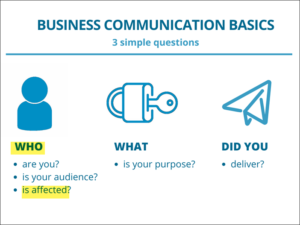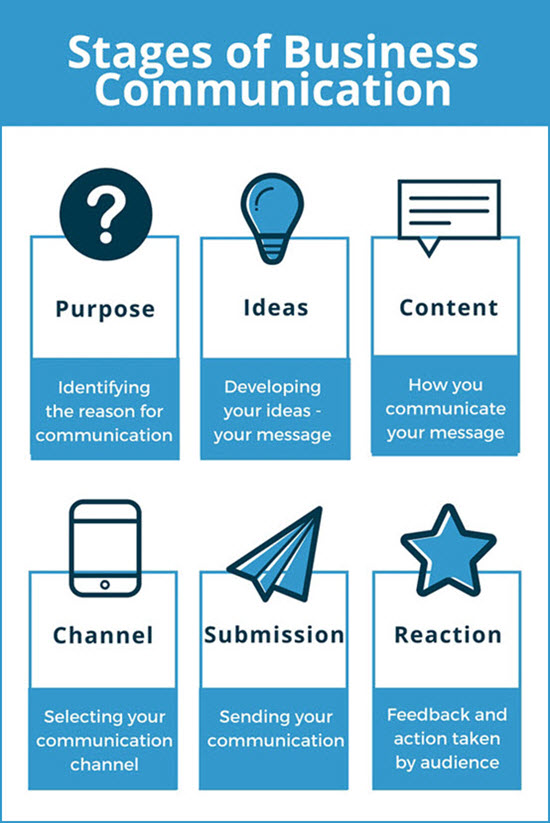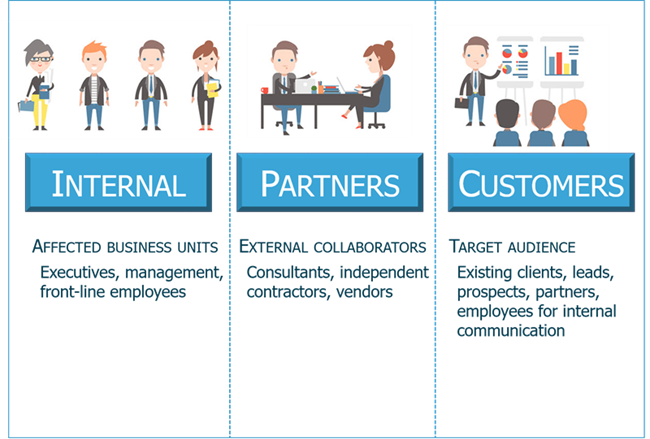Part of the Who is Affected series

 Okay, so not sharing business communication may be less than life-threatening. But have you ever felt like you were the last person to hear about changes? Changes that have a direct impact on what you do.
Okay, so not sharing business communication may be less than life-threatening. But have you ever felt like you were the last person to hear about changes? Changes that have a direct impact on what you do.
Tick you off? Yeah, me too.
Sharing business communication with the people who need to know sounds logical, doesn’t it? But how often have you (or another key person) been left out of the loop?
In the Who is Your Audience series, you will discover there are more than customers in your business communication audience.
Sharing Business Communication with Stakeholders
In corporate speak, key persons are known as stakeholders. Stakeholders get REALLY unhappy when left out of the conversation.
- Do you really want someone holding a stake to be ticked off at you?
- How do you avoid that and protect your life?
- Well, at least your business life.
Keep stakeholders in the loop.
Stages and Stakeholders
Your business communication does not magically appear – no matter how much you wish it would. Like most work tasks, business communication has stages to get to that final version.
Below is an illustration of six typical stages for creating content.

Let me ask you this. How often has every business communication gone exactly as planned? Even the best laid plans hit a bump or two.
Ensuring you keep the right people in the loop is a good way to minimize stumbles.
Start by identifying your key persons (I like that term so much better than stakeholders).
Identifying Key Persons
The business world often identifies senior executives as key persons. For business communications, our definition is broader.
A quick way to identify a key person is after something goes wrong. Like when sales forget to tell customer service about a promise made to a client. Ouch.
Waiting for something negative to happen is probably not the best way for identifying key persons. Let’s start by thinking who our key persons may be. I like using the following categories.

Notice how your employees could be customers when sending internal business communications. If you think of employees in that perspective, you may do a better job of communicating with them.
Also, you could simply identify key persons as internal and external (which combines Partners and Customers). Use whatever works best for you and your business.
Checking it Twice
Imagine the list Santa Claus must have. Santa does not leave the accuracy of his list to chance. He checks it twice – it says so right in the song, Santa Claus is Coming to Town.
- Ask other team members who should be on the list.
- Revise your list, based on input.
- Tweak your list for the best match.
Your key persons list is dynamic. It will change, depending on the communication and which stage of the process you’re at.
Matching Key Persons to Stages
Raise your hand if you have experienced any of the following frustrations.
- Too many meetings with too many players
- Emails with a cc list that rivals infinity
- Projects that wither and die
I can hear the screaming now.
It is possible to have too much of a good thing. Because you created an awesome list of key persons does not mean you need to include every Tom, Dick, and Harriet for all stages of business communication.
Think of your key persons list like your trip to the all-you-can-eat buffet.
- Must-haves – These are the people with the knowledge and expertise to contribute something of value.
- Would be nice – You can count on these individuals to enthusiastically support your efforts.
- Not worth the calories (energy) – Some may contribute little or have little influence over outcomes.
Key Person Template
I put together a Key Person template to help you identify key persons and the best individuals to include in your specific business communication. Download a pdf version of the Key Person template by clicking on the above link.
Let me know what you think. What would you add? Change?
Yes, labeling ineffective sharing of business communication as life-threatening may be a tad overstated. But I cannot get that image out of my head of a key person with a stake in his or her hand.
I don’t know about you, but I’d rather avoid the drama.
What tips do you have for keeping key persons in the loop? Share your thoughts in Comments.
Note: The next post reviews how you define the purpose of your business communication.
==================================
==================================
Note: This post originally published on March 21, 2016. This August 17, 2022 version updates it.
===================================

I like stakeholders. Because way too often, communication is limited to those consider the key individuals- and then all hell breaks loose when others have no clue about mission change, mission creep, special projects, and the like.
But, I am DEFINITELY for communication (and open financials with employees and executives, to boot).
I get your point, Roy. It depends on how you define “key persons” – or stakeholders for that matter. You’re right. Communication is what makes it work or fail. Thanks for sharing your thoughts, Roy.